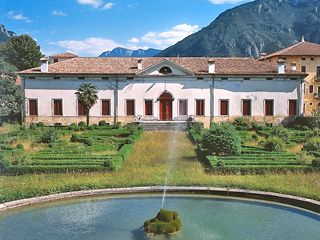Villa Velo and Villa La Montanina

Leaving behind the hamlet of Seghe, we find the little town of Velo d’Astico, renamed Villascura by Fogazzaro in his novel Daniele Cortis, and indicated as such on the signpost along the road. Following the directions we come to Villa Velo, a landmark in this area, and re-christened Villa Cortis in the novel Daniele Cortis, home of the main character and evocatively described in the following excerpt:
Sky and mountain, all was black, from the Passo Grande, which carries on its lowest ledge the Villa Cortis, with its woods and fields, away to Monte Barco, and to the high, narrow gully, whence issues the Rovese torrent. At the top of the steps, against the whitish background of the house, a lighted door shone in the darkness. […] on his right, rising above him, were the branches of the dense wood which grows over the mountain and valley, and which covers peaks and ridges, streams and pools , with the terrors of its black shadows. The wonderful fountain in the garden made its voice heard, though it was invisible in the night […]
Villa Velo, the magnificent historic residence of the Velo family, stands near the ancient castle of Velo and over the centuries it has been added to and altered. The oldest part is the huge three-floored main body that was built in the seventeenth century preserves elements of both Gothic and Renaissance styles. The section which links it to the beautifully crafted barchessa, or outhouses, was built by Girolamo di Velo in 1752 and displays interesting stuccoes and frescoes by G.B. Canal, a central staircase, and two serliana windows to the sides.
The chapel is finely decorated with sculptures from the school of Marinali. The villa is surrounded by a garden with a fountain and on the valley-facing side is a red marble column (brought back by Count Girolamo Egidio di Velo from the archaeological dig he conducted in the Baths of Caracalla in Rome), central to one of Elena’s most compelling scenes in the novel:
[…] a stream covered with water-lilies trickled, the grass grew thickly over the path, and overhead the branches of the acacias on either side mingled, and cast a golden green shadow. Thence she mounted to a quiet opening in the hills, and there, among the trees on a grassy plateau, stood a column of ancient marble, brought from the baths of Caracalla to this other solitude, and bearing on its base two clasped hands carved in relief, and the following words:
HYEME ET AESTATE ET PROPE ET PROCUL USQUE DUM VIVAM ET ULTRA
Following the signs, a few hundred metres further up, is La Montanina, “Leila’s villa” in the novel of the same name. Fogazzaro had it built in 1907, overseeing every detail of its design with the architect Mario Ceradini, and in keeping with the dictates of Liberty and Viennese Secessionist styles (steep-sloped roofs, trapezoidal pediments, and small-squared window panes). The writer watched over the building works as if it were his own child and christened the springs in the grounds Riderella and Modesta. The house was severely damaged by air raids in 1916 as the Austrian command was based there. It was then bought by Monseigneur Franceso Galloni and rebuilt and extended between 1927 and 1932 to become the centre for the Opera “Pro Oriente”, a charitable institution set up during the Fascist period. Earlier fragments of the older building include parts of a painting of the Magi, which are now mostly covered by an Annunciation, and a four-sided herm inscribed with the date 1907. The central salon has an enormous window overlooking the valley, framed by columns from Pompeii and two stately staircases. The nearby chapel is dedicated to Santa Maria dei Monti. Fogazzaro depicts the villa in this charming personification:
[…] it is so like one of those peasant women who come wearily down from the steeps of Priaforà, and pause to rest awhile upon the bundle of wood they have gathered in the forests. Or as one guest commented, ‘A big house with a family of children’.

